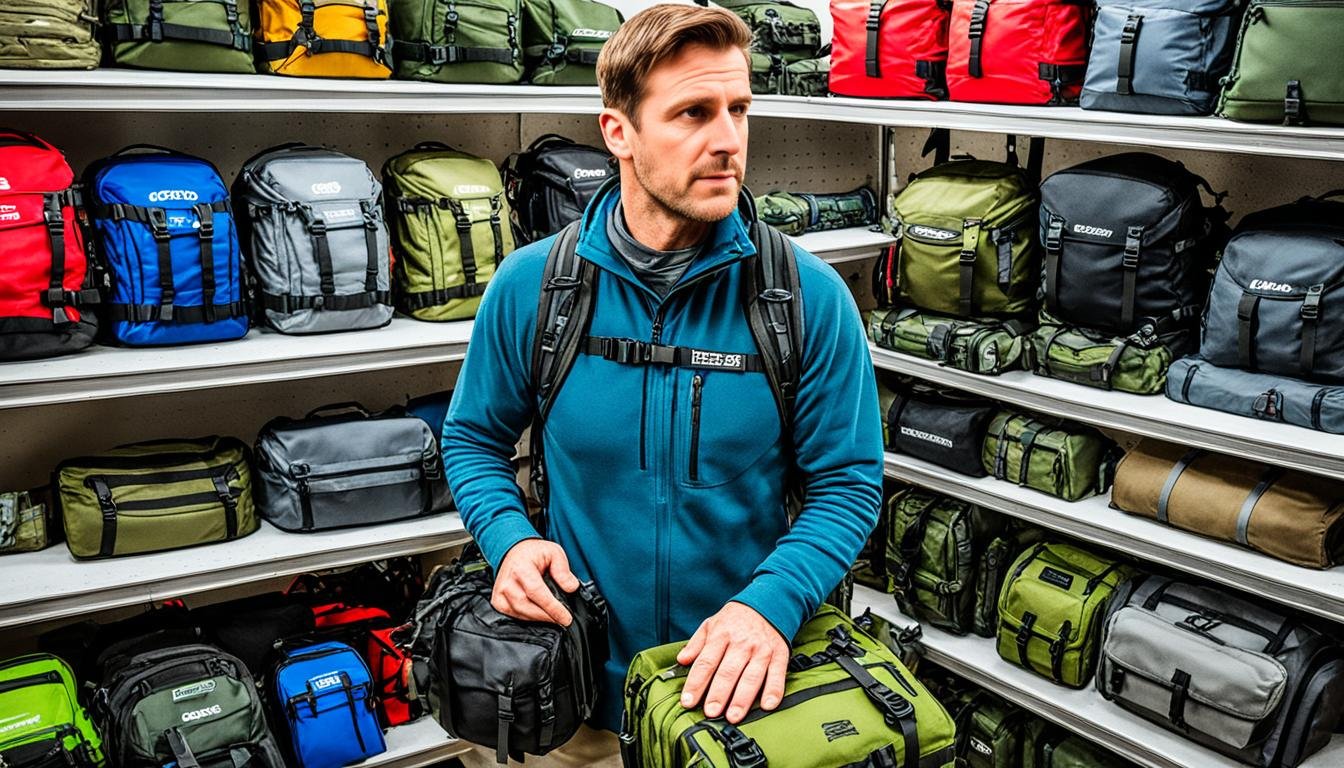Imagine every second matters, and you must leave everything but one item. That item is your emergency survival kit: your bug out bag. It stands as the ultimate support in tough times, a light of readiness in chaos. Yet, did you wonder if your bug out bag can truly keep you safe in a disaster? Choosing the right bug out gear, from your bag’s durability to the items inside, could mean safety or danger.
I have a deep interest in disaster readiness. To me, a bug out pack is more than just packing essentials in a bag. It’s about carefully selecting what you need to face unexpected emergencies. Let me help you put together an emergency go bag. It’s not just an item; it’s your lifeline.
Key Takeaways
- Identifying the must-have items for a complete bug out bag.
- Evaluating the traits that make a survival backpack fit for different disaster situations.
- The value of a well-planned emergency evacuation bag can be the key to survival or risk.
- Finding the right balance between having what you need and being able to move quickly with your bug out gear.
- Choosing the best bug out pack tailored to your needs and surroundings.
Determining Your Bug Out Bag Essentials
Being ready with a well-equipped bug out bag is crucial in an emergency. It involves knowing what to pack as bug out bag essentials and why they are vital. My checklist must match personal needs and possible challenges without being too heavy. Each survival gear piece is selected for its importance in emergency preparedness.
Understanding the Basics of a Bug Out Bag
Learning the basics of a bug out bag is key. This survival kit is more than handy; it’s your life support in tough situations. It should include things for food, shelter, safety, and stability. My goal is to have what I need to stay alive, stay protected, signal for help, and handle injuries.
Assessing Personal Needs and Environment
Choosing what goes into my bug out bag starts with understanding personal needs and the environment. The weather, the land, and possible disasters guide my gear choices. I always think about the right clothes, shelter, and food for the setting.
Prioritizing Items for Efficiency and Space
When filling my bug out bag, I focus on what’s essential and what fits. The aim is to pack light but smart, balancing necessity with practicality. A lighter bag means I can move faster and for longer, which is often critical in emergencies.
| Category | Essentials | Notes |
|---|---|---|
| Water | Water filter, purification tablets | Consider local water sources and potential contaminants. |
| Food | Non-perishable food items | Balance between energy-providing and nutritional value. |
| Shelter | Compact, weather-appropriate tent or tarp | Should be quick to set up and take down. |
| Clothing | Layered, durable, and weather-appropriate | Include items that can serve multiple purposes. |
| Tools | Multi-tool, fire starter, sturdy knife | Focus on multi-functionality and reliability. |
| First Aid | Customized first aid kit | Adjust contents based on personal medical needs. |
| Navigation | Compass, maps | GPS devices are optional but require power solutions. |
| Signaling | Whistle, mirror, flares | Visibility in both sight and sound is essential for rescue. |
| Documentation | Copies of critical documents | Keep in a waterproof container. |
A Bug Out Bag for Every Scenario
Being ready for a disaster means having the right bug out bag. Not every emergency is the same, so it’s key to know this. Your bag’s contents should match the challenge, whether it’s natural disasters, unrest, or health crises.
- Natural Disasters: For these, pack a waterproof poncho, thermal blankets, and a hand-crank radio. Also, have easy-to-prepare, non-perishable food ready.
- Civil Unrest: A low-key backpack can help you blend in. Add a detailed local map and, if it’s legal and you’re trained, self-defense tools.
- Public Health Emergencies: Stock up on masks, gloves, and sanitizers for health crises. Include a first aid kit with your meds and health must-haves.
Your bug out bag needs to fit your skills, health, and knowledge of your area. Customizing it for different emergencies ensures you’re ready. This will boost your chances of staying safe no matter the situation.
Navigating the Essentials: Water, Food, and Shelter
Having the right bug out bag essentials is key when disaster hits. Clean drinking water is a top priority. That’s why methods of water purification are essential. You might need to use chemical tablets, filters, or boiling to make water safe. This ensures you can turn any water into a drinkable resource.
Next, let’s talk about emergency food supplies. It’s important to pack foods that give you energy and last a long time. Include things like ready-to-eat meals, calorie-dense bars, and dry fruits and nuts. These items keep your energy up without taking too much space. But it’s not all about calories; making sure you have nutritious food is also key.
Then, there is the matter of shelter options. You might need a sturdy tent, a multi-use tarp, or an emergency blanket. Having a way to stay protected from bad weather and feel safe is crucial. Here’s a quick guide to help you choose:
| Shelter Type | Pros | Cons |
|---|---|---|
| Tent | Durable, privacy, protection from insects and small animals | Heavier and bulkier, more time-consuming setup |
| All-weather Tarp | Lightweight, versatile, quick setup | Less protection, requires additional tools for setup |
| Emergency Space Blanket | Ultra-lightweight, reflective material for heat retention | Minimal protection, one-time use |
Being ready for an emergency means solid preparation. Make sure to have good water purification options, a range of emergency food, and different shelter options in your bug out bag. With these essentials, you’ll be set for whatever challenges you face.
Choosing the Right Bag: Comfort, Durability, and Space
When getting ready for emergencies, picking the right bug out bag is crucial. It must be comfortable, tough, and have enough room. A good bag makes sure you can carry all you need. You’ll move quickly and safely in a crisis.
Essential Features of a Quality Bug Out Bag
Seeking comfort in a backpack? Look for padded straps and an ergonomic shape. These features help spread the weight evenly. Durability comes from strong materials and well-made construction. This keeps your gear safe in tough spots. For space, find a bag that’s big enough for your stuff but not too bulky.
Tactical vs. Traditional Backpacks for Your Gear
The debate over tactical versus traditional backpacks for emergency bags continues. Tactical ones are sturdy and versatile but may stand out in the city. Traditional backpacks, however, fit better into everyday scenes. They’re more low-key for carrying emergency items.
| Feature | Tactical Backpacks | Traditional Backpacks |
|---|---|---|
| Material | Heavy-duty, water-resistant | Varied, often less rugged |
| Compartments | MOLLE system, customizable | Fixed compartments, streamlined design |
| Design | Military-inspired, conspicuous | Civilian look, more inconspicuous |
| Comfort | Ergonomic, structured | Comfort varies by model and brand |
| Suitability | Rugged environments, quick access to gear | Urban settings, casual use |
Take your time to consider the features of backpacks against your needs. Whether you choose tactical or traditional backpacks, the best bag is the one that fits your personal situation. It should keep you ready for anything unexpected.
The Role of Tools and Equipment in a Bug Out Bag
In my bug out bag, sturdy tools and equipment are key. They are more than just extras. They are the foundation of survival. I will share the critical tools that could save your life.
Survival Tools: From Multi-tool to Hatchet
When picking survival tools, I go for ones that are versatile and reliable. A multi-tool is super useful. It merges knives, pliers, and screwdrivers into one. A hatchet is great not only for cutting wood but also as a hammer and for defense.
Essential Survival Gear: Fire Starters and Navigation Tools
Fire starters in my bag are crucial. Making a fire is essential for heat, food, and signaling. So, I carry waterproof matches, a flint striker, and a magnesium rod. Navigation tools are also important. I always have a durable compass and local maps. Plus, a solar-powered GPS adds an extra safety net, if it works.
Communication and Emergency Signals for Safety
In an emergency, being able to talk and send signals is key to staying safe. Having bug out bag communication tools and knowing emergency signals can save your life. It’s important to not only have these tools but also know how to use them right.
Every prepared bug out bag should include some key communication tools and emergency signals:
- Two-way radios for constant, reliable communication between parties within a certain range.
- Solar powered charger to keep your small electronic devices powered up without the need for electricity.
- Whistles which can be used to alert rescuers or communicate with your group using pre-arranged codes.
- Air horns that can send out loud, long-distance signals, ideal for attracting attention in spacious areas.
- Mirrors or reflective devices can be used for signaling over long distances during the day.
It’s vital to have a plan for these tools. Think about who you need to talk to and how. What if you can’t speak; do you have a signal plan? Practice is essential. Making sure your group knows the safety measures can change everything.
| Tool | Purpose | Best Use Scenario |
|---|---|---|
| Two-way radios | Real-time communication | When traveling in a group across short to medium distances |
| Solar charger | Device recharging | No access to power during prolonged periods outdoors |
| Whistle | Audible signaling over distance | When lost or trying to alert nearby help without using much energy |
| Air horn | Loud signaling over vast areas | To alert rescue services from a long distance |
| Mirror/reflective device | Visual signaling especially in daylight | When you need to catch the attention of aircraft or distant rescuers during the day |
Don’t overlook non-tech emergency signals. Three sounds (like gunshots or whistle blasts) signal distress worldwide. Three items in a visible spot can ask for help.
In preparing, it’s crucial to have layered safety measures. That means more than one way to signal for help. A good bug out bag communication plan prepares for many situations. Being over-prepared could save your life.
Conclusion: Packing a Bug Out Bag That’s Right for You
Making a personalized bug out bag is key in disaster readiness. Our guide breaks down the complex process of crafting an emergency survival kit into easy steps. With this knowledge, you can confidently build a bug out bag that meets your needs. It considers possible scenarios and the essentials needed. This custom approach provides not just safety, but also the confidence to face emergencies.
Picking the right balance between practicality and weight is crucial. It’s important not to skip vital items but to also keep the bag light. The chosen items for water, food, shelter, tools, communication, and safety make the kit strong yet complete. Each part of the bug out gear adds to your survival chances, highlighting the importance of being self-reliant during tough times.
Creating the perfect emergency preparedness plan means there’s no one perfect bug out bag. Disasters vary, so our preparation must be dynamic and customized. Regularly updating and refining your bag’s contents keeps you ready for any situation. This guide leads you to be well-prepared, enabling you to face emergencies with resilience and smart planning.


